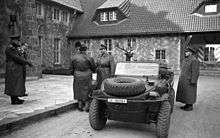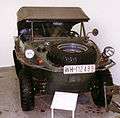Volkswagen Schwimmwagen
| Volkswagen Type 166 'Schwimmwagen' | |
|---|---|
 | |
| Overview | |
| Manufacturer | Volkswagen |
| Production | 14,265 (1942–44) |
| Body and chassis | |
| Related | VW type 86 & 87 |
| Powertrain | |
| Engine |
4-cyl. boxer, air cooled 1,131 cc, 25 hp @ 3,000 rpm |
| Transmission |
4-speed manual 2-speed transfer case; 4WD only on 1st gear / reverse |
| Dimensions | |
| Wheelbase | 200 cm (78.7 in) |
| Length | 382.5 cm (150.6 in) |
| Width | 148 cm (58.3 in) |
| Height | 161.5 cm (63.6 in) |
| Curb weight | 910 kg (1,345 kg GVW) |
The VW Type 128 and 166 Schwimmwagen (literally Floating/Swimming Car) were amphibious four-wheel drive off-roaders, used extensively by German ground forces during the Second World War. The Type 166 is the most numerous mass-produced amphibious car in history .
Development

Volkswagen Schwimmwagens used the engine and mechanicals of the VW Type 86 four-wheel drive prototype of the Kübelwagen and the Type 87 four-wheel drive 'Kübel/Beetle' Command Car, which in turn were based on the platform of the civilian Volkswagen Beetle. Erwin Komenda, Ferdinand Porsche's first car body designer, was forced to develop an all-new unitized bodytub structure since the flat floorpan chassis of the existing VW vehicles was unsuited to smooth movement through water. Komenda patented his ideas for the swimming car at the German Patent office.
The earliest Type 128 prototype was based on the full-length Kübelwagen chassis with a 240 cm (7.9 ft) wheelbase. Pre-production units of the 128, fitted with custom welded bodytubs, demonstrated that this construction was too weak for tough off-roading, had insufficient torsional rigidity, and easily suffered hull-ruptures at the front cross-member, as well as in the wheel-wells. This was unacceptable for an amphibious vehicle. The large-scale production models (Type 166) were therefore made smaller, and had a wheel-base of only 200 cm (6.6 ft).
VW Schwimmwagens were produced by the Volkswagen factory at Fallersleben / Wolfsburg and Porsche's facilities in Stuttgart; with the bodies (or rather hulls) produced by Ambi Budd in Berlin. 15,584 Type 166 Schwimmwagen cars were produced from 1941 through 1944; 14,276 at Fallersleben and 1,308 by Porsche. Given these numbers, the VW 166 is the most mass-produced amphibious car in history. Only 189 [1] are known by the Schwimmwagen Registry to remain today, and only 13 have survived without restoration work.[2]
Technology

All Schwimmwagen were four wheel drive only on first gear (and reverse gears with some models) and had ZF self-locking differentials on both front and rear axles. Just like the Kübelwagen, the Schwimmwagen had portal gear rear hubs that gave better ground clearance, while at the same time reducing drive-line torque stresses with their gear reduction at the wheels.
When crossing water a screw propeller could be lowered down from the rear deck engine cover. When in place a simple coupling provided drive straight from an extension of the engine's crankshaft. This meant that screw propulsion was only available going forward. For reversing in the water there was the choice of using the standard equipment paddle or running the land drive in reverse, allowing the wheel-rotation to slowly take the vehicle back. The front wheels doubled up as rudders, so steering was done with the steering wheel both on land and on water.
Images
 Hermann Göring with a Schwimmwagen at Carinhall
Hermann Göring with a Schwimmwagen at Carinhall German officers in a Schwimmwagen in France in 1944
German officers in a Schwimmwagen in France in 1944 Schwimmwagen from the December 1944 issue of the Intelligence Bulletin
Schwimmwagen from the December 1944 issue of the Intelligence Bulletin Schwimmwagen at RAF Duxford
Schwimmwagen at RAF Duxford Schwimmwagen interior
Schwimmwagen interior Type 166 Schwimmwagen
Type 166 Schwimmwagen Schwimmwagen at the Army Museum Dresden
Schwimmwagen at the Army Museum Dresden Detail of Schwimmwagen propeller
Detail of Schwimmwagen propeller- Schwimmwagen
 A Schwimmwagen loaded with Panzerfaust 60 anti-tank weapons
A Schwimmwagen loaded with Panzerfaust 60 anti-tank weapons- Type 166 Schwimmwagen at the Muzeum Dopravy Bratislava
- Schwimmwagen, Motorshow Lahti
In fiction
The amphibious vehicle in the manga and anime series Kokoro Library, used by the three sisters who maintain the titular library, is very reminiscent of a Volkswagen Schwimmwagen, as is the vehicle used by Section III in Pumpkin Scissors. It was also used in the Polish TV series Samochodzik i templariusze (Mr Automobile and Knight Templars) as the main character's amphibious car (to which he owes his nickname), although in the book the car is described as modified Ferrari 410 Superamerica. The vehicle is also featured in the game Company of Heroes as alternate units. It also makes an appearance in the racing simulator Gran Turismo 5 and the war game Battlefield 1942: Secret Weapons of WW2. The "Scouter" in Fallout Tactics: Brotherhood of Steel is based on one of these too, though with various modifications.
See also
- Amphicar
- DUKW
- LuAZ-967
- Ford GPA (A similar Jeep-based vehicle used by the Allies.)
- Toyota's Su-Ki, Japanese World War II boat-hulled amphibious truck
References
Notes
- ↑ http://www.vw166.com/
- ↑ Lemmens, Bart. "VW-Schwimmwagen type 166 - The VW-Schwimmwagen Registry". Vw166.com. Retrieved 2009-07-25.
Bibliography
- René Pohl: Mit dem Auto baden gehen. HEEL Verlag, Gut-Pottscheidt Konigswinter 1998, ISBN 3-89365-702-9
External links
| Wikimedia Commons has media related to Volkswagen Schwimmwagen. |
- U.S. Intelligence report on German Schwimmwagen
- The VW-Schwimmwagen Registry
- Schwimmwagen enthusiast site
- Schwimmwagen Photos of the Schwimmwagen at the Canada War Museum in Ottawa
- UK Schwimmwagen owners site
